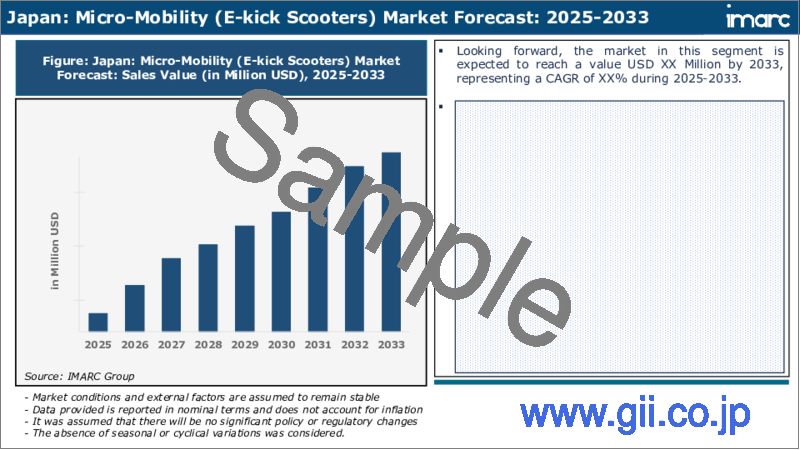|
|
市場調査レポート
商品コード
1609765
日本のマイクロモビリティ市場レポート:タイプ別、推進タイプ別、シェアリングタイプ別、速度別、年齢層別、所有別、地域別、2025年~2033年Japan Micro-Mobility Market Report by Type, Propulsion Type, Sharing Type, Speed, Age Group, Ownership, and Region 2025-2033 |
||||||
カスタマイズ可能
|
|||||||
| 日本のマイクロモビリティ市場レポート:タイプ別、推進タイプ別、シェアリングタイプ別、速度別、年齢層別、所有別、地域別、2025年~2033年 |
|
出版日: 2024年12月05日
発行: IMARC
ページ情報: 英文 116 Pages
納期: 5~7営業日
|
全表示
- 概要
- 目次
日本のマイクロモビリティ市場の市場規模は2024年に38億米ドルに達しました。今後、IMARC Groupは、2033年には139億米ドルに達し、2025~2033年の成長率(CAGR)は15.5%になると予測しています。バッテリー技術の進歩や効率的な電気モーターの市場開拓が進み、電動スクーターやe-bike、その他のマイクロモビリティの製造と運用が容易になったことが市場を牽引しています。
本レポートで扱う主な質問
- 日本のマイクロモビリティ市場のこれまでの業績と今後の業績は?
- COVID-19が日本のマイクロモビリティ市場に与えた影響は?
- 日本のマイクロモビリティ市場のタイプ別内訳は?
- 日本のマイクロモビリティ市場の推進タイプ別の内訳は?
- 日本のマイクロモビリティ市場のシェアリングタイプ別の内訳は?
- 日本のマイクロモビリティ市場の速度別の内訳は?
- 日本のマイクロモビリティ市場の年齢層別の内訳は?
- 日本のマイクロモビリティ市場の所有別の内訳は?
- 日本のマイクロモビリティ市場のバリューチェーンにはどのような段階がありますか?
- 日本のマイクロモビリティの主な促進要因と課題は何か?
- 日本のマイクロモビリティ市場の構造と主要プレーヤーは?
- 日本のマイクロモビリティ市場における競合の程度は?
目次
第1章 序文
第2章 調査範囲と調査手法
- 調査の目的
- ステークホルダー
- データソース
- 市場推定
- 調査手法
第3章 エグゼクティブサマリー
第4章 日本のマイクロモビリティ市場:イントロダクション
- 概要
- 市場力学
- 業界動向
- 競合情報
第5章 日本のマイクロモビリティ市場情勢
- 過去および現在の市場動向(2019年~2024年)
- 市場予測(2025-2033)
第6章 日本のマイクロモビリティ市場:タイプ別の内訳
- 自転車
- 電動自転車
- 電動キックスクーター
- その他
第7章 日本のマイクロモビリティ市場:推進タイプ別の内訳
- マニュアル
- 電動
- ハイブリッド
第8章 日本のマイクロモビリティ市場:シェアリングタイプ別の内訳
- ドッキング
- ドックレス
第9章 日本のマイクロモビリティ市場:速度別の内訳
- 時速25キロ未満
- 時速25キロ以上
第10章 日本のマイクロモビリティ市場:年齢層別の内訳
- 15-34
- 35-54
- 55歳以上
第11章 日本のマイクロモビリティ市場:所有別の内訳
- 企業間取引
- 企業対消費者
第12章 日本のマイクロモビリティ市場:競合情勢
- 概要
- 市場構造
- 市場プレーヤーのポジショニング
- 主要成功戦略
- 競合ダッシュボード
- 企業評価象限
第13章 主要企業のプロファイル
第14章 日本のマイクロモビリティ市場- 業界分析
- 促進要因・抑制要因・機会
- ポーターのファイブフォース分析
- バリューチェーン分析
第15章 付録
Japan micro-mobility market size reached USD 3.8 Billion in 2024. Looking forward, IMARC Group expects the market to reach USD 13.9 Billion by 2033, exhibiting a growth rate (CAGR) of 15.5% during 2025-2033. The increasing advances in battery technology and the development of efficient electric motors, which have made it easier to manufacture and operate electric scooters, e-bikes, and other micro-mobility vehicles, are driving the market.
Micro-mobility refers to the integration of small, lightweight transportation options into urban transport networks designed to cover short distances and provide last-mile connectivity. Typically powered by electric motors, these vehicles include e-scooters, e-bikes, and other compact personal transport devices. The rise of micro-mobility is driven by the increasing need for sustainable, efficient, and congestion-reducing transportation alternatives in crowded urban areas. These services often operate on a share-based model, allowing users to rent vehicles through smartphone applications, contributing to the ease of access and flexibility in urban commuting. Micro-mobility solutions address gaps in traditional public transportation systems, providing a convenient option for short trips that might be too long to walk but too short to drive. By reducing reliance on personal automobiles for short distances, micro-mobility can significantly decrease traffic congestion, lower greenhouse gas emissions, and contribute to improved air quality. Furthermore, it promotes active transportation, potentially leading to health benefits for users.
Japan Micro-Mobility Market Trends:
The micro-mobility market in Japan is witnessing unprecedented growth, driven by several key factors. Firstly, urbanization is on the rise, and with it, the need for efficient, eco-friendly transportation solutions. Consequently, city dwellers are increasingly turning to micro-mobility options, such as electric scooters and bikes, as viable alternatives to traditional cars, alleviating traffic congestion and reducing carbon emissions. Furthermore, the widespread adoption of smartphone technology has played a pivotal role in the expansion of this market. Seamless connectivity and user-friendly mobile apps have made it easier than ever for individuals to locate, unlock, and pay for micro-mobility services, fostering convenience and accessibility. Additionally, the growing awareness of environmental sustainability is propelling the market forward as more consumers seek eco-conscious modes of transportation. Moreover, regulatory support and initiatives from local governments are bolstering the micro-mobility sector. Favorable policies, infrastructure development, and partnerships with micro-mobility providers are creating an enabling environment for growth. In conclusion, the micro-mobility market in Japan is being propelled by a confluence of factors, including urbanization, technological advancements, environmental consciousness, and government support.
Japan Micro-Mobility Market Segmentation:
Type Insights:
- Bicycles
- E-Bike
- E-kick Scooters
- Others
Propulsion Type Insights:
- Manual
- Electrically-Powered
- Hybrid
Sharing Type Insights:
- Docked
- Dock-Less
Speed Insights:
- Less Than 25 Kmph
- Above 25 Kmph
Age Group Insights:
- 15-34
- 35-54
55 and Above
Ownership Insights:
- Business-To-Business
- Business-To-Consumer
Competitive Landscape:
The market research report has also provided a comprehensive analysis of the competitive landscape. Competitive analysis such as market structure, key player positioning, top winning strategies, competitive dashboard, and company evaluation quadrant has been covered in the report. Also, detailed profiles of all major companies have been provided.
Key Questions Answered in This Report:
- How has the Japan micro-mobility market performed so far and how will it perform in the coming years?
- What has been the impact of COVID-19 on the Japan micro-mobility market?
- What is the breakup of the Japan micro-mobility market on the basis of type?
- What is the breakup of the Japan micro-mobility market on the basis of propulsion type?
- What is the breakup of the Japan micro-mobility market on the basis of sharing type?
- What is the breakup of the Japan micro-mobility market on the basis of speed?
- What is the breakup of the Japan micro-mobility market on the basis of age group?
- What is the breakup of the Japan micro-mobility market on the basis of ownership?
- What are the various stages in the value chain of the Japan micro-mobility market?
- What are the key driving factors and challenges in the Japan micro-mobility?
- What is the structure of the Japan micro-mobility market and who are the key players?
- What is the degree of competition in the Japan micro-mobility market?
Table of Contents
1 Preface
2 Scope and Methodology
- 2.1 Objectives of the Study
- 2.2 Stakeholders
- 2.3 Data Sources
- 2.3.1 Primary Sources
- 2.3.2 Secondary Sources
- 2.4 Market Estimation
- 2.4.1 Bottom-Up Approach
- 2.4.2 Top-Down Approach
- 2.5 Forecasting Methodology
3 Executive Summary
4 Japan Micro-Mobility Market - Introduction
- 4.1 Overview
- 4.2 Market Dynamics
- 4.3 Industry Trends
- 4.4 Competitive Intelligence
5 Japan Micro-Mobility Market Landscape
- 5.1 Historical and Current Market Trends (2019-2024)
- 5.2 Market Forecast (2025-2033)
6 Japan Micro-Mobility Market - Breakup by Type
- 6.1 Bicycles
- 6.1.1 Overview
- 6.1.2 Historical and Current Market Trends (2019-2024)
- 6.1.3 Market Forecast (2025-2033)
- 6.2 E-Bike
- 6.2.1 Overview
- 6.2.2 Historical and Current Market Trends (2019-2024)
- 6.2.3 Market Forecast (2025-2033)
- 6.3 E-kick Scooters
- 6.3.1 Overview
- 6.3.2 Historical and Current Market Trends (2019-2024)
- 6.3.3 Market Forecast (2025-2033)
- 6.4 Others
- 6.4.1 Historical and Current Market Trends (2019-2024)
- 6.4.2 Market Forecast (2025-2033)
7 Japan Micro-Mobility Market - Breakup by Propulsion Type
- 7.1 Manual
- 7.1.1 Overview
- 7.1.2 Historical and Current Market Trends (2019-2024)
- 7.1.3 Market Forecast (2025-2033)
- 7.2 Electrically-Powered
- 7.2.1 Overview
- 7.2.2 Historical and Current Market Trends (2019-2024)
- 7.2.3 Market Forecast (2025-2033)
- 7.3 Hybrid
- 7.3.1 Overview
- 7.3.2 Historical and Current Market Trends (2019-2024)
- 7.3.3 Market Forecast (2025-2033)
8 Japan Micro-Mobility Market - Breakup by Sharing Type
- 8.1 Docked
- 8.1.1 Overview
- 8.1.2 Historical and Current Market Trends (2019-2024)
- 8.1.3 Market Forecast (2025-2033)
- 8.2 Dock-Less
- 8.2.1 Overview
- 8.2.2 Historical and Current Market Trends (2019-2024)
- 8.2.3 Market Forecast (2025-2033)
9 Japan Micro-Mobility Market - Breakup by Speed
- 9.1 Less Than 25 Kmph
- 9.1.1 Overview
- 9.1.2 Historical and Current Market Trends (2019-2024)
- 9.1.3 Market Forecast (2025-2033)
- 9.2 Above 25 Kmph
- 9.2.1 Overview
- 9.2.2 Historical and Current Market Trends (2019-2024)
- 9.2.3 Market Forecast (2025-2033)
10 Japan Micro-Mobility Market - Breakup by Age Group
- 10.1 15-34
- 10.1.1 Overview
- 10.1.2 Historical and Current Market Trends (2019-2024)
- 10.1.3 Market Forecast (2025-2033)
- 10.2 35-54
- 10.2.1 Overview
- 10.2.2 Historical and Current Market Trends (2019-2024)
- 10.2.3 Market Forecast (2025-2033)
- 10.3 55 and Above
- 10.3.1 Overview
- 10.3.2 Historical and Current Market Trends (2019-2024)
- 10.3.3 Market Forecast (2025-2033)
11 Japan Micro-Mobility Market - Breakup by Ownership
- 11.1 Business-To-Business
- 11.1.1 Overview
- 11.1.2 Historical and Current Market Trends (2019-2024)
- 11.1.3 Market Forecast (2025-2033)
- 11.2 Business-To-Consumer
- 11.2.1 Overview
- 11.2.2 Historical and Current Market Trends (2019-2024)
- 11.2.3 Market Forecast (2025-2033)
12 Japan Micro-Mobility Market - Competitive Landscape
- 12.1 Overview
- 12.2 Market Structure
- 12.3 Market Player Positioning
- 12.4 Top Winning Strategies
- 12.5 Competitive Dashboard
- 12.6 Company Evaluation Quadrant
13 Profiles of Key Players
- 13.1 Company A
- 13.1.1 Business Overview
- 13.1.2 Product Portfolio
- 13.1.3 Business Strategies
- 13.1.4 SWOT Analysis
- 13.1.5 Major News and Events
- 13.2 Company B
- 13.2.1 Business Overview
- 13.2.2 Product Portfolio
- 13.2.3 Business Strategies
- 13.2.4 SWOT Analysis
- 13.2.5 Major News and Events
- 13.3 Company C
- 13.3.1 Business Overview
- 13.3.2 Product Portfolio
- 13.3.3 Business Strategies
- 13.3.4 SWOT Analysis
- 13.3.5 Major News and Events
- 13.4 Company D
- 13.4.1 Business Overview
- 13.4.2 Product Portfolio
- 13.4.3 Business Strategies
- 13.4.4 SWOT Analysis
- 13.4.5 Major News and Events
- 13.5 Company E
- 13.5.1 Business Overview
- 13.5.2 Product Portfolio
- 13.5.3 Business Strategies
- 13.5.4 SWOT Analysis
- 13.5.5 Major News and Events
14 Japan Micro-Mobility Market - Industry Analysis
- 14.1 Drivers, Restraints, and Opportunities
- 14.1.1 Overview
- 14.1.2 Drivers
- 14.1.3 Restraints
- 14.1.4 Opportunities
- 14.2 Porters Five Forces Analysis
- 14.2.1 Overview
- 14.2.2 Bargaining Power of Buyers
- 14.2.3 Bargaining Power of Suppliers
- 14.2.4 Degree of Competition
- 14.2.5 Threat of New Entrants
- 14.2.6 Threat of Substitutes
- 14.3 Value Chain Analysis





